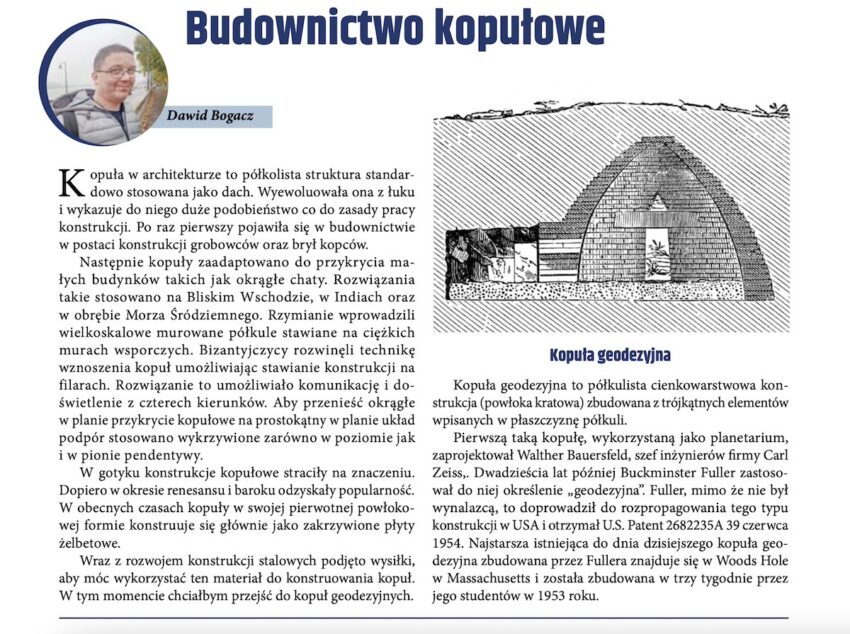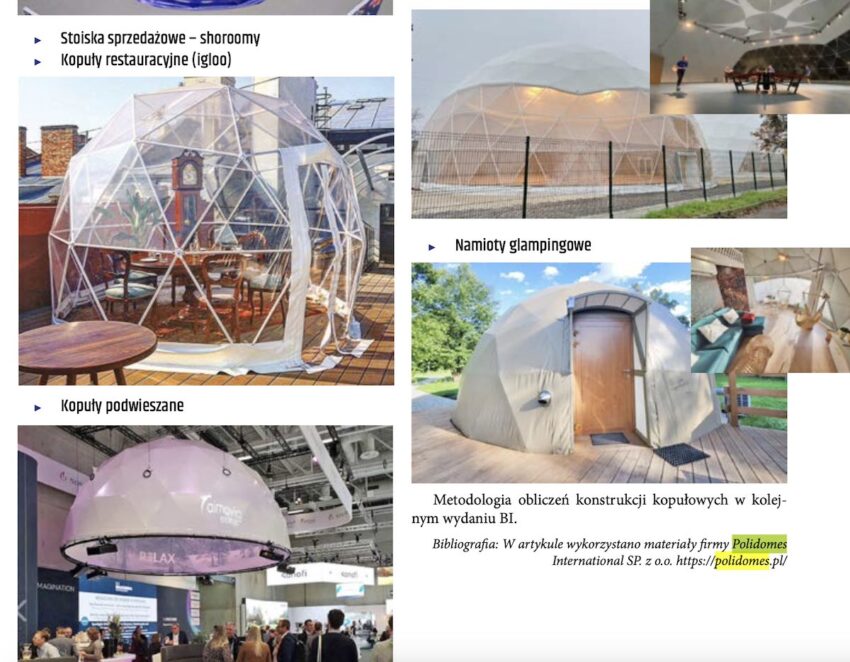Polidomes has been featured in the quarterly magazine of the Polish Chamber of Engineers. This magazine covers various topics and curiosities within the field of construction. The March 2023 issue was dedicated, among other things, to assistance in the reconstruction of Ukraine, the construction of modern bridges, and dome construction.

Historical Overview: The article highlighted that domes have been used in construction for centuries, for example, in the form of tombs or mounds. Later, this shape was adapted for residential construction, with small dome-shaped huts being built in the Middle East, India, and the Mediterranean region. However, domes lost significance during the Gothic period, only to regain popularity during the Baroque and Renaissance periods. Nowadays, domes are mainly constructed using curved reinforced concrete panels, but lighter and more mobile solutions such as geodesic grids made of steel pipes of varying lengths are also utilized.
Definition and Pioneers: A geodesic dome is a hemispherical thin-shell structure built from triangular elements fitted into the surface of a hemisphere. The first such dome, used as a planetarium, was designed by Walter Bauersfeld, head engineer of the Carl Zeiss company. Twenty years later, Buckminster Fuller coined the term “geodesic” for it. Fuller, despite being an inventor, popularized this type of construction in the USA and obtained a patent for it in 1954. The oldest existing geodesic dome built by Fuller is located in Woods Hole, Massachusetts, and was constructed in three weeks by his students in 1953. The concept of the geodesic dome appealed to Fuller because it allowed for very large spans and loads for a very lightweight structure. Additionally, a hemisphere contains the largest volume for the smallest external surface area.



Applications: Geodesic domes have been successful as special constructions such as early warning system buildings in remote areas of Canada, Kaiser aluminum domes, auditoriums, meteorological observatories, and others. The first widespread application of the geodesic dome in mainstream construction was the Gold Dome in Oklahoma City, used as a bank. It gained wider attention at the 1964 World’s Fair in New York, with a dome designed by Thomas C. Howard, which is now used as an aviary in the Queens Zoo. In 1975, a dome was erected at the South Pole, where it had to withstand extreme wind and snow loads.
Design and Materials: Geodesic domes are constructed using various materials and methods, including wooden frames covered with plywood, steel structures covered with canvas or glass, prefabricated reinforced concrete, and aluminum (as a substitute for steel).
Contemporary Use of Steel Structures: The article focused on contemporary applications of steel domes, highlighting their wide use in the entertainment, exhibition, and hospitality industries due to their futuristic appearance. The ease of assembly and disassembly of dome connections allows them to serve as both temporary and year-round buildings.
Polidomes as an Example: The article mentioned Polidomes as a company with many examples of dome applications in its portfolio. Special attention was paid to event tents, which are the company’s showcase. Other temporary structures showcased included amphitheaters, restaurant tents, and suspended domes. Glamping, sports halls, and banquet halls represented the category of year-round domes. We are proud that Polidomes was chosen as the hero of the material!
